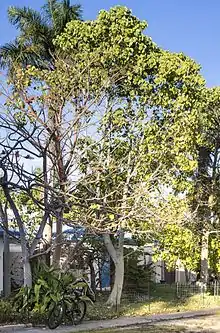| Hildegardia populifolia | |
|---|---|
 | |
| H. populifolia tree cultivated in Hollywood, Florida, USA | |
| Scientific classification | |
| Kingdom: | Plantae |
| Clade: | Tracheophytes |
| Clade: | Angiosperms |
| Clade: | Eudicots |
| Clade: | Rosids |
| Order: | Malvales |
| Family: | Malvaceae |
| Genus: | Hildegardia |
| Species: | H. populifolia |
| Binomial name | |
| Hildegardia populifolia | |
| Synonyms | |
| |
Hildegardia populifolia is a species of flowering plant in the family Malvaceae. It is found only in the Eastern Ghats of Andhra Pradesh and Tamil Nadu in India.[1] It is threatened by habitat loss; just about 20 trees are known to exist on the eastern slopes of the Kalrayan Hills.[1]
This is a deciduous tree growing up to 20 meters tall. It has lobed leaves and panicles of flowers with red sepals and no petals. Most trees produce both male and bisexual flowers.[3]
The bee Trigona iridipennis feeds on the pollen and nectar. The flowers are visited by several bird species, such as the red-vented bulbul (Pycnonotus cafer), rufous-backed shrike (Lanius schach), blue-tailed bee-eater (Merops philippinus), and stork-billed kingfisher (Pelargopsis capensis), some of which are predators of the bee.[3]
References
- 1 2 3 World Conservation Monitoring Centre (1998). "Hildegardia populifolia". IUCN Red List of Threatened Species. 1998: e.T33656A9801072. doi:10.2305/IUCN.UK.1998.RLTS.T33656A9801072.en. Retrieved 16 November 2021.
- ↑ Hinsley, Stewart Robert. "The Hildegardia Page". Malvaceae Info. Retrieved 2 May 2010.
- 1 2 Raju, A. J. S., Chandra, P. H., & Krishna, J. R. (2014). Monoecy, anemophily, anemochory and regeneration ecology of Hildegardia populifolia (Roxb.) Schott. and Endl.(Malvaceae), an economically important endemic and endangered dry deciduous tree species of southern Eastern Ghats, India. Journal of Threatened Taxa, 6(2), 5434-5446.
